Four Beneficial Insects as Babies
By Ann M. Mason, Fairfax Master Gardener Intern
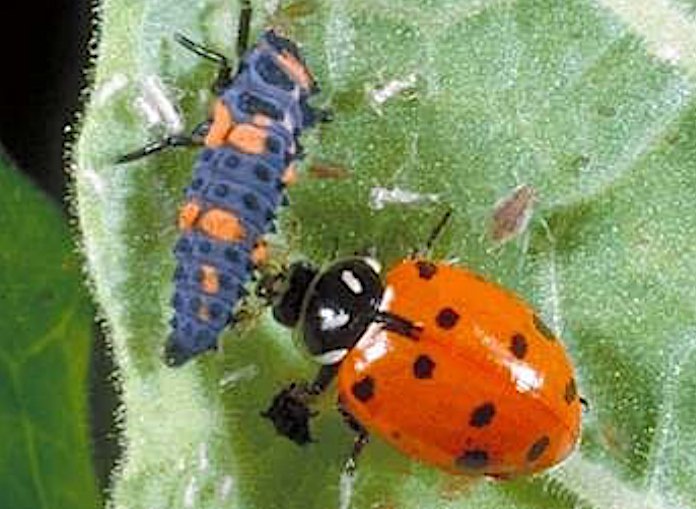
Ladybug nymph & adult
Most of us love to see photos of babies — our own, farm animals and wildlife. But when it comes to insects, some of us might get squeamish. Members of my own family are known to squeal, “Bugs! Ick!”
If we set the squeamish aside, I suspect many gardeners are eager to learn what beneficial insects look like as babies. Who wants to deliberately kill an ally consumed with an intense focus on attacking and feeding on garden pests? In the pursuit of seeking ‘bad bugs,’ we are garden buddies with beneficial insects.
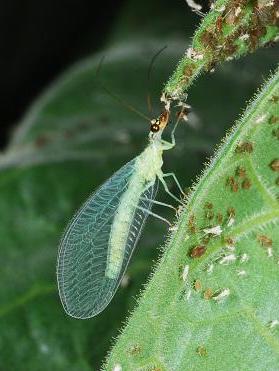
Adult lacewing
Let’s look at the forms (egg, larva, adult) of four beneficial insects that consume some of our problematic garden insect pests. Ladybugs (also known as lady beetles and lady bird beetles) include a group of common predators in several species in the family Coccinellidae. Known as voracious eaters, they eat as many as 5,000 aphids during the lifetime of a single beetle. Adults are easy to recognize with the oval-shaped, brightly colored convex bodies with spots. Generally, ladybugs can be yellow, pink, orange, red or black, with contrasting dark spots.
In Virginia, we might see our native Hippodamia convergens, the convergent lady beetle; the Coccinella septempunctata, the seven-spotted lady beetle; Coleomegilla maculata, the pink lady beetle; or the recently introduced and problematic Harmonia axyridis, the Asian lady beetle. It competes for the territory of our native lady beetle and becomes a problem in the fall when it seeks shelter in homes. The convergent lady beetle has up to 13 black spots on the wing covering (elytra) and sports a white line surrounding the prothorax that converges behind the head. The seven-spotted lady beetle has seven black dots on the elytra when closed — three of which sit on top of the beetle forming a triangle. Each side has two more spots, and on each side of the central dot are small white patches.
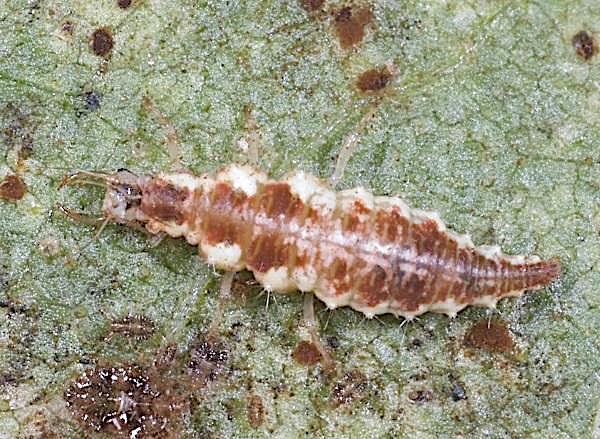
Lacewing larva
Lady beetles are true beetles and have a complete life cycle. The eggs are laid in clusters on a leaf near an aphid infestation. The eggs hatch into alligator-like larvae with bumpy backs. For several weeks the larvae are voracious eaters before forming pupates on leaves, then emerging as adult beetles. The adults move to other food sources if pests are scarce. The observant gardener can often find all stages at the same time, especially where aphids are plentiful.
Lacewing Flies include green lacewing (Chrysopa spp.) and brown lacewing (Micromus spp.) in the family Chrysopidae. Both are important predators of aphids, mites, thrips, soft scales and other soft-bodied prey. Green lacewings feed on aphids, pollen and honeydew. The golden-eyed adult green lacewing has transparent wings with an interconnecting vein network. An adult green lacewing can lay 400 to 500 eggs, each singly placed atop a threadlike stalk on a leaf to prevent predation by sibling hatchlings. The larval form earns its name ‘aphid lion’ from its spindle shape with two sickle-shaped jaws with which it impales its prey to inject enzymes and digests the prey’s body. The long tail section provides the larvae a stabilization brace during this attack. Larvae develop for one to two weeks prior to the adult stage. The brown lacewing is smaller than its green cousin and is seen earlier in the season. Its larvae are similar in structure.
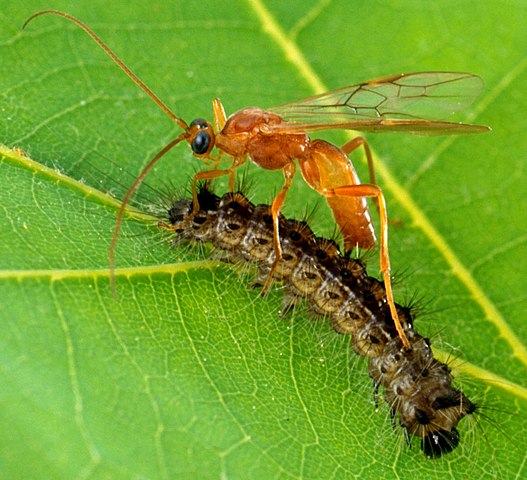
Mummy wasp & gypsy moth caterpillar
Parasitic Wasps are shaped like other wasps with a ‘waist’ between the thorax and the abdomen. They differ from other wasps in that some part of their life cycles occurs in or on the body of a host. Females of different species of parasitic wasps seek their host at different host stages. Some like the small scelionid wasp specialize by injecting eggs into the egg of a host; others like the small black wasp
(Muscidifurax raptor) inject eggs into cocoons or pupa; still others like the emerald wasp
(Ampulex compressa) seek adult hosts. While the gardener is unlikely to see the eggs, they might see the larva or pupa stage of some parasitic wasps on the outside of their food hosts. Many of these larvae appear like white grubs on their host prior to darkening into the pupa stage. For some parasitic wasp species, the pupa stage resembles the adult wasp.
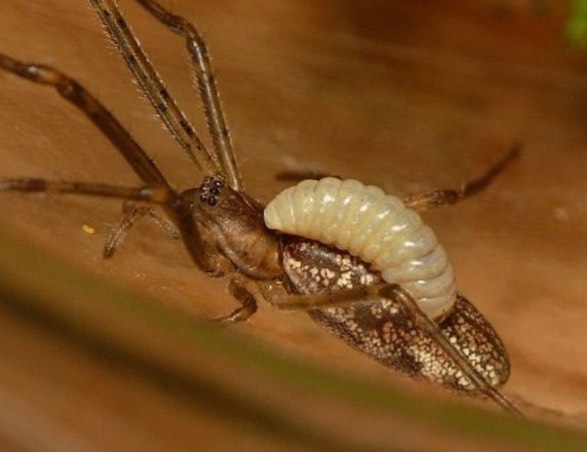
Polysphinctine Wasp larva on spider
Tachinid Flies are parasitic flies, and the larvae are important pest control agents that feast on hosts from within. Favorite host pests of the tachinid fly include beetles, moths, earwigs, grasshoppers and sawflies. All members of this large group of flies lay small white or greyish eggs either on leaves where they are eaten by caterpillars or by inserting eggs or maggots directly into or onto host pests. Regardless of the egg attachment method, the developing larvae (maggots) consume their host from within. While larvae (maggots) are usually inside the host and not seen, pupae appear as small, dark red, oblong cases. The adults are easily confused with the common house fly. Look at the tip of the abdomen. If you see stout, hairy bristles protruding, you are looking at a beneficial tachinid fly rather than an annoying house fly. Two tachinids we might see in our Mid-Atlantic gardens include
Trichopoda pennipes, the feather-legged fly, that feasts on stink bugs and squash bugs, and
Istocheta aldrichi, that preys on Japanese beetles.

Tachinid fly and larva
To attract and keep these beneficial insects, the gardener needs a tolerance for some pests to provide a food source for them. A few plants with aphids will attract beneficial predators and their offspring to the garden, to be ready to help when needed. So, if you happen to see the young stages of these beneficial predators, the gardener can rest easy, even rejoice, that no control is necessary because nature is ready to provide needed control.
Resources
• Green Lacewing, Ric Bessin, University of Kentucky
• Lacewings, D. G. Pfeiffer, Virginia Tech, Aphid Predators in Mid-Atlantic Orchard Monitoring Guide
• Parasitic Wasps, Teresa Dellinger and Eric Day, Virginia Cooperative Extension, Virginia Tech
Publication ENTO-74NP
• Parasitoid Wasps (Hymenoptera), Mike Raupp, Jon Traunfeld, and Chris Sargent, University of
Maryland Extension Services
• Tachinid Flies, University of California Integrated Pest Management Program
• Parasitoids – Tachinid Fly (Diptera), Mike Raupp, Jon Traunfeld, and Chris Sargent, University of
Maryland Extension
• Parasitoid Muscidifurax raptor, Nicholas Tucker and Phillip Kaufman, Featured Creatures, University
of Florida
• Good Bugs–Bad Bugs, Cleve Campbell, Piedmont Master Gardeners, Virginia Cooperative Extension





